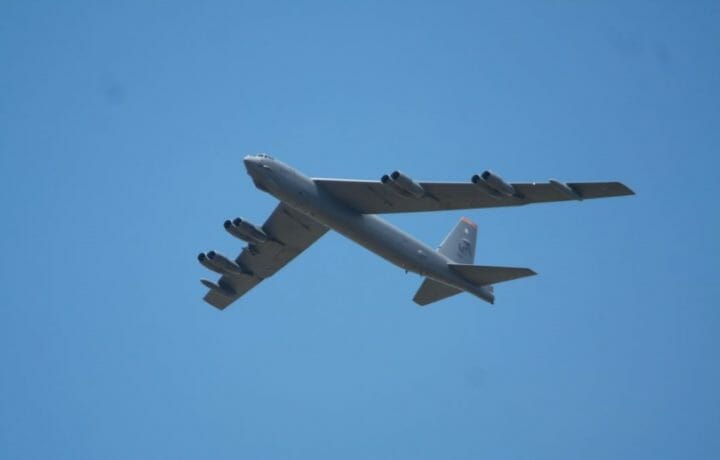Not counting the United States Navy’s USS Constitution, which remains officially in “active service” even if she is essentially a museum ship, there are few military platforms that have been in service as long as the Boeing B-52 Stratofortress. The long-range strategic bomber first took flight at a time when fewer than half of Americans had a TV set, and when rock and roll music was the hot new thing (not to mention a potential danger to the youth).
By the time the bombers are finally retired, which is now scheduled for sometime in the 2050s, the B-52 will have been in service for around a century. Throughout its already impressive seven decades in service, the aircraft has been steadily upgraded. This has included everything from the installation of Raytheon’s AESA AN/APG-79 radar to the addition of new navigation and communication systems and even the installation of a privacy screen for the aircraft’s single lavatory!
Though 744 were built, with the final aircraft being delivered in October in 1962, there are currently 76 in the United States Air Force’s inventory. Of those 58 are active with the 2nd Bomb Wing and 5th Bomb Wing, while 18 more are in reserve with the 307th Bomb Wing. Another dozen are in long-term storage at the Davis-Monthan Air Force Base (AFB) “Boneyard.”
Meet The B-52J
What is notable is that many of the early improvements resulted in new designations, with the final batch produced being the B-52H. More recent upgrades have been considered so minor – privacy screen included – that the Air Force never changed the aircraft’s model number.
Yet, the Commercial Engine Replacement Program (CERP) has been seen as significant enough that the service announced this month that once completed, the aircraft would be redesignated the B-52J. It is also a long-time in coming.
Since the 1970s, Boeing has investigated replacing the engines, and it took up the idea again in the 1990s. The Air Force rejected the idea, arguing that replacing the engines would cost more than keeping the existing ones. The service was forced to change course, however, due in part to the fact that the Air Force had failed to take into account the increase in fuel costs.
As a result, in April 2020, the service released its request for proposals (RFP) for a new commercial engine. In September 2021, the Air Force announced that it had selected the Rolls-Royce F-130 engines, which will swap out the original Pratt & Whitney TF-33 engines. Rolls-Royce was awarded the $2.6 billion CERP contract to keep the B-52 flying into the 2050s.
The new engines were seen as a significant upgrade from the current Pratt & Whitney-made TF33 engines, which date back to the early 1960s. The F-130 was seen as a well-tested and proven engine, and the platform had accumulated more than twenty-seven million engine flight hours.
Digital Efforts
It should also be added that this upgrade is utilizing many digital tools that didn’t exist in the 1970s and which were barely available even in the 1990s. Swapping the engine required some retooling of the aging warbirds.
Rolls-Royce has already utilized state-of-the-art digital engineering tools to best determine how to incorporate the engines in the aging bombers. The engine maker has already created digital maps of the massive bombers, and that has allowed engineers to map models of the new engines to conclude how these would interact with other components and systems. This also involved the two companies trading digital models, which further helped engineers ensure that the F-130 could fit precisely inside the B-52 nacelles and determine where newly added components can be placed.
Reaching a Milestone
Air Force Acquisition Chief Andrew Hunter met with U.S. lawmakers to provide an update on the program. The U.S. Air Force now expects to reach a Milestone B decision on the engines by September.
That would allow the CERP to begin engineering and manufacturing development as well as a transition away from the middle tier of acquisition rapid prototyping effort under which it now operates.
“I have a fairly high degree of confidence we’ll be ready in the fall,” Hunter said at a hearing before the House Armed Services Committee’s sea power panel, Defense News first reported.
The acquisition chief further explained that the B-52′s new commercial-derivative engines will be able to use a broader supply chain than the current Pratt & Whitney TF33 engines, which frequently break and which have problems with parts availability.
Other changes to the bomber under the CERP will include updates to the flight systems, cockpit throttles, and displays.
B-52J But No B-52K… Yet
The new B-52J designation will come as the result of the new commercial engines and associated subsystems, the Air Force announced in justification documents for its 2024 budget request. Yet, that has led to some confusion as some of the bombers have already received the installation of Raytheon’s AESA AN/APG-79 radar, along with new navigation and communication systems.
This would mean that some B-52Js have the new radar but not the engines.
There was speculation the engine upgrade would therefore call for the B-52K designation, but the Air Force is apparently sticking with the J designation – at least for now.
Long Flying Bomber
The B-52 was the first U.S. long-range, swept-wing heavy bomber. The Stratofortress originally entered service as an intercontinental, high-altitude bomber, but its operational capabilities have been adapted over the past seven decades to meet changing defense needs. This included modifications for low-level flight, conventional bombing, and extended-range flights.
The current fleet of B-52s can launch ballistic and cruise missiles hundreds of miles from their targets, and there had been efforts to develop hypersonic weapons that can be employed with the bombers. Yet, last month, the Air Force announced it would close out the AGM-183 Air-Launched Rapid Response Weapon (ARRW) after a couple more tests.
The Air Force now expected the B-52Js with new engines and radars to be ready for service by the end of the decade.




